
The Seward Highway is a highway in the U.S. state of Alaska that extends 125 miles (201 km) from Seward to Anchorage. It was completed in 1951 and runs through the scenic Kenai Peninsula, Chugach National Forest, Turnagain Arm, and Kenai Mountains. The Seward Highway is numbered Alaska Route 9 (AK-9) for the first 37 miles (60 km) from Seward to the Sterling Highway and AK-1 for the remaining distance to Anchorage. At the junction with the Sterling Highway, AK-1 turns west towards Sterling and Homer. About eight miles (13 km) of the Seward Highway leading into Anchorage is built to freeway standards. In Anchorage, the Seward Highway terminates at an intersection with 5th Avenue, which AK-1 is routed to, and which then leads to the Glenn Highway freeway.

Flattop Mountain is a 3,510 feet (1,070 m) mountain in the U.S. state of Alaska, located in Chugach State Park just east of urban Anchorage. It is the most climbed mountain in the state.

Eagle River is a community within the Municipality of Anchorage situated on the Eagle River, for which it is named, between Joint Base Elmendorf-Richardson and Chugach State Park in the Chugach Mountains. Its ZIP code is 99577. Settled by homesteaders, Eagle River has been annexed to the Municipality of Anchorage since the 1970s—a relationship that is, at times, complicated. On the one hand, Eagle River functions as an Anchorage suburb, with a number of Eagle River residents working in, shopping or participating in community life in the Anchorage bowl. Much of the community is also made up of residents from nearby Joint Base Elmendorf-Richardson. On the other hand, the community is itself a significant business hub between Wasilla and Anchorage, offering shopping, restaurants, recreation and employment. Secession efforts have from time to time gained traction by residents who would like Eagle River legally regarded as a separate community. Eagle River also has a close relationship with its neighboring community to the north, Chugiak, with which it shares some history. If Eagle River were not part of the Municipality of Anchorage, it would be classified as one of the five largest cities in Alaska.
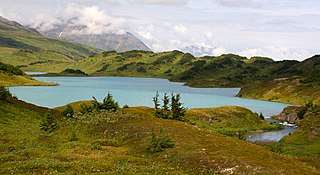
The Chugach National Forest is a 6,908,540-acre (27,958 km2) United States National Forest in south central Alaska. Covering portions of Prince William Sound, the Kenai Peninsula and the Copper River Delta, it was formed in 1907 from part of a larger forest reserve. The Chugach includes extensive shorelines, glaciers, forests and rivers, much of which is untouched by roads or trails. It hosts numerous bird, mammal and marine species, including extensive shorebird habitat and a bald eagle population larger than the contiguous 48 states combined. Human industry in the forest includes extensive tourism and some mining and oil and gas operations.

Chugach State Park covers 495,204 acres covering a hilly region immediately east of Anchorage, in south-central Alaska.

Hatcher Pass is a mountain pass through the southwest part of the Talkeetna Mountains, Alaska. It is named after Robert Hatcher, a prospector and miner. The nearest cities are Palmer and Wasilla approximately 12 miles (19 km) to the south, and Willow approximately 26 mi (42 km) to the west. The communities are at an elevation of approximately 250 ft (76 m) in the Mat-Su valley.
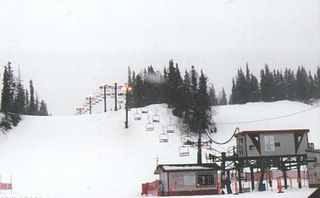
Hilltop Ski Area is a ski area in Anchorage, Alaska established in 1984. Located in Far North Bicentennial Park near Chugach State Park at the base of the Chugach Mountains, Hilltop Ski Area is owned and operated by Youth Exploring Adventure, Inc., an Anchorage nonprofit 501(c)(3) organization established in 1979 to provide recreational programs for Anchorage youth.

The Municipality of Anchorage is the largest city in the U.S. state of Alaska by population. With a population of 291,247 at the 2020 census, it contains nearly 40% of the state's population. The Anchorage metropolitan area, which includes Anchorage and the neighboring Matanuska-Susitna Borough, had a population of 398,328 in 2020, accounting for more than half the state's population. At 1,706 sq mi (4,420 km2) of land area, the city is the fourth-largest by area in the United States and larger than the smallest state, Rhode Island, which has 1,212 sq mi (3,140 km2).
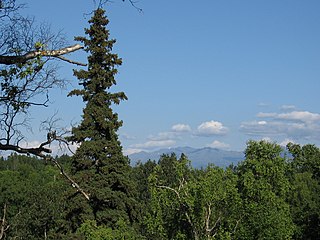
Kincaid Park is a 1,516.78-acre (6.1382 km2) municipal park in Anchorage, Alaska, located at 9401 W. Raspberry Road. The park is bounded on the south by Turnagain Arm, on the west by Knik Arm, and on the north by Ted Stevens Anchorage International Airport. Noted for Nordic skiing trails, in snowless months the park is frequented by runners, bikers, hikers, archers, dog-trainers, motocross users, disc golfers, soccer teams, and rollerskiers. Other winter activities include snowshoeing, sledding and biathlon. The park was created in 1978 and later expanded to include the location of a deactivated former Nike missile site. The park continues to evolve with changing demands of local residents. In 2009, a full 18 "hole" disc golf course that meanders through the wooded Mize Loop area was completed. In 2010, several new soccer fields were completed and open for use in the area near the chalet. In 2012, a single artificial turf soccer field with stadium seating was completed just south of the park's headquarters building, Kincaid Chalet. Cook Inlet, Fire Island with its wind turbines, and Mount Susitna are visible from most hilltops in the park. On a clear day, Denali can also be seen from the park.
Point Woronzof Park is a municipal park in Anchorage, Alaska known for its views of Denali. The park is excellent for backcountry skiing or snowshoeing in the winter, and biking or running in the summer.
The following is a list of sporting venues, events, and teams based in Alaska.
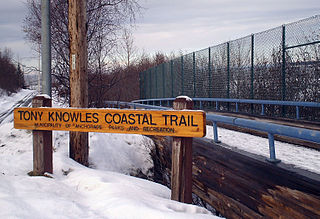
Template:Off more citations needed

The Eagle River is a stream, 40 miles (64 km) long, in Anchorage, Alaska. Heading at Eagle Glacier in Chugach State Park, it flows northwest into Eagle Bay on the Knik Arm of Cook Inlet, 9 miles (14 km) northeast of downtown Anchorage.

Chester Creek is one of several streams that flow through the city of Anchorage, Alaska. It runs for 21 miles (34 km) from the Chugach Mountains to the Knik Arm of Cook Inlet.

Indian is a community in the Municipality of Anchorage, Alaska, United States. It lies in a valley in the Chugach Mountains near the middle of the north shore of the Turnagain Arm of Cook Inlet. It is about 24 miles (39 km) southeast of downtown Anchorage and about 3 miles (4.8 km) northwest of Bird, and about 13 miles (21 km) west-northwest of Girdwood.

Summit Lake is located on Canyon Creek in the Chugach National Forest, Alaska, United States and is situated along the Seward Highway (AK-1) 10 miles (16 km) north-northeast of Moose Pass and about 23 miles (37 km) southwest of the Portage area of Anchorage. The lake is fed by Canyon Creek from the southwest and Tenderfoot Creek from the east. The lake empties into Canyon Creek on the northeast, which flows through Lower Summit Lake, into Six Mile Creek, and eventually into the Turnagain Arm of the Cook Inlet.

Eklutna Lake is a 1,424.5 hectares lake in the Municipality of Anchorage, Alaska, near the village of Eklutna. It is located entirely inside Chugach State Park and is about 1 mile (1.6 km) wide and 7 miles (11 km) in length.
The Far North Bicentennial Park is the largest park in Anchorage, in U.S. state of Alaska, and has over 1 million annual visitors. The park contains the Hilltop Ski Area, the Alaska Botanical Garden, over 100 miles of multi-use trails, and access to Chugach State Park.
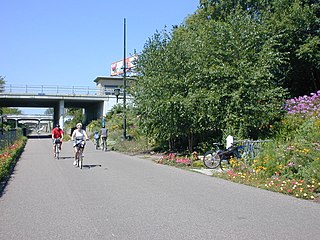
Minneapolis is often considered one of the top biking and walking cities in the United States due to its vast network of trails and dedicated pedestrian areas. In 2020, Walk Score rated Minneapolis as 13th highest among cities over 200,000 people. Some bicycling ratings list Minneapolis at the top of all United States cities, while others list Minneapolis in the top ten. There are over 80 miles (130 km) of paved, protected pathways in Minneapolis for use as transportation and recreation. The city's Grand Rounds National Scenic Byway parkway system accounts for the vast majority of the city's shared-use paths at approximately 50 miles (80 km) of dedicated biking and walking areas. By 2008, other city, county, and park board areas accounted for approximately 30 miles (48 km) of additional trails, for a city-wide total of approximately 80 miles (130 km) of protected pathways. The network of shared biking and walking paths continued to grow into the late 2010s with the additions of the Hiawatha LRT Trail gap remediation, Min Hi Line pilot projects, and Samatar Crossing. The city also features several natural-surface hiking trails, mountain-biking paths, groomed cross-country ski trails in winter, and other pedestrian walkways.
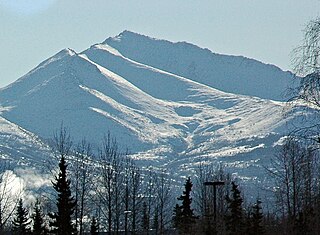
Wolverine Peak is a 4,491-foot (1,369 m) mountain summit located in the western Chugach Mountains, in Anchorage Municipality, in the U.S. state of Alaska. Wolverine Peak is situated in Chugach State Park, 10 mi (16 km) southeast of downtown Anchorage, and 2.6 mi (4 km) northwest of O'Malley Peak. It is a prominent mountain on the Anchorage skyline. This geographic feature was so-named in 1963 by members of the Mountaineering Club of Alaska who found wolverine tracks in the snow near the summit. The name was officially adopted in 1964 by the U.S. Board on Geographic Names. A popular hike on a five-mile trail leads to the summit with views of Mount Williwaw, Denali, Mount Foraker, Cook Inlet, and Anchorage.






















